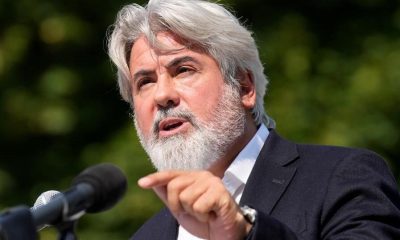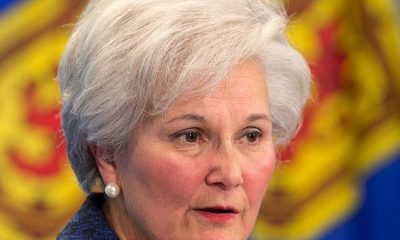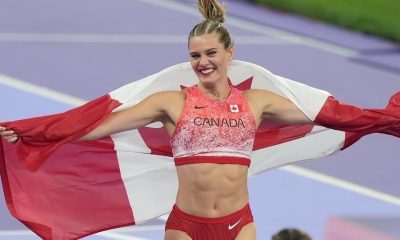BRANDON, Mississippi (AP) — Soon after Ashanta Laster reached the hospital, she was ushered into the emergency room where she saw doctors performing CPR on her teenage son.
Laster had gotten a call that 17-year-old Phillip Laster Jr., a lineman who played for a top Mississippi high school, had collapsed on the field during an August 2022 practice. At the time, the family says the heat index was 102 degrees (38.9 degrees Celsius) on the football field.
“They kept compressing his chest trying to bring him back. No response, no response. Never a heartbeat,” said Laster, recalling how she dropped her purse, called her husband and started praying.
“I said I was going to call all the prayer warriors and bring my son back. I wanted him to come back,” she continued. “At that point, it was just an unbelievable moment. I can’t believe my son was gone. I could not believe it … I was in a state of shock … that he died … at football practice.”
The death of Laster underscores the dangers facing high school football players, mostly in the Southeast, who are collapsing and dying in late summer at the start of season. Players are most at risk of suffering heat-related illnesses due to searing temperatures and high humidity. Those conditions have worsened in recent decades due to climate change, with extremely hot days becoming more frequent since 1970 in 88% of locations nationwide analyzed by Climate Central, a nonprofit science research group.
At least 58 players have died from exertional heat stroke between 1992 and 2024, according to the Korey Stringer Institute at the University of Connecticut, and thousands more are sickened each year. This summer has been especially bad, with five high school players dying since July of suspected heat-related illnesses, including 14-year-old Semaj Wilkins who collapsed during drills last month at his Alabama high school practice.
“I just want to know what really happened that day. What was he doing? From the autopsy and the doctor’s standpoint, what did y’all see what was going on? You know, I just want answers,” said Wilkins’ mother, Regina Adams.
One study found that high school football players are 11 times more likely to suffer heat illnesses than all other sports combined.
Experts believe football players are more vulnerable because they wear heavy equipment that traps heat and have bigger body sizes that produce more heat, especially offensive and defensive lineman who can can weigh upwards of 300 pounds. They also may not yet be fully acclimated to working out in summer conditions, sometimes play on artificial turf which increases the heat and may have underlying health conditions.
“We know that heat stroke is the most severe version of heat illness, is the only one that is life threatening and also know that it uniquely afflicting football players specifically at high school and collegiate levels,” said Rebecca Stearns, the Institute’s chief operating officer, adding that their research found that 94% of cases over the past four decades of heat stroke in sports involved football players.
Another driver of these deaths is the culture of football, where coaches have long drilled into players the idea of playing through pain and pushing through adversity. That is starting to change, but many high schools still lack necessary equipment and protocols which experts said can reduce heat-related illnesses and prevent deaths.
“There are a lot of athletic programs that are not prepared for traumatic injuries. They’re not prepared for sudden cardiac arrest, and they’re not prepared for exertional heat stroke,” said Laurie Giordano, who formed a foundation to raise awareness about heat illnesses after her son Zach Martin, a high school football player in Florida, died in 2017. The family reached a nearly $1 million settlement with the school district over his death.
“These things are happening more and more so you know they need to be prepared,” she continued. “They need to know signs and symptoms. They need to know how to react. They need to have and practice their emergency action plan.”
Stearns said most states are not doing enough to protect kids — a problem made worse by the fact there are no federal heat policies for high school sports. Heat policies are sometimes set by state high school athletic associations or by state or local governments.
Only a quarter of states have comprehensive heat acclimatization policies, Stearns said, which regulate rest periods, phasing in of equipment and numbers of training sessions a day. Only a quarter have polices requiring the use of wet-bulb globe temperature — considered the best way to measure heat stress since it includes ambient air temperature, humidity, direct sunlight and wind — to determine whether its too hot to practice.
Less than a third of states require cold water immersion tubs on site — one of the best ways to treat a player suffering heat illness.
Many school districts also lack athletic trainers, the person best qualified to spot and treat heat illness and pull a sick player off the field. According to the latest data from the Athletic Training Locations and Services Project, a joint initiative of the Institute and the National Athletic Trainers’ Association, about a third of high school athletes lack access to athletic training services.
Others lack an emergency action plan, which lays out steps staff need to take if a player falls sick, with only 32 states requiring them, Stearns said. Complicating safety efforts are resources, with poorest districts often lacking the means to afford protective equipment and athletic trainers.
The best policies, like those in Georgia, Louisiana, New Jersey and New Hampshire, include heat acclimatization guidance, weather-based modifications, availability of cold water immersion tubs and protocol for treating heat illness including cooling a player before transporting them to the hospital.
The case of Laster illustrates some the fatal mistakes his family believes happened and ultimately led to his death. Mississippi’s heat policy at the time fell short in several areas, including requiring no emergency action plan nor wet-bulb globe temperature monitoring.
According to a federal lawsuit filed in January against the Rankin County School District, the first practice was held on the hottest part of the day and didn’t give players any time to adapt. They went right into an intense conditioning. When Laster began showing symptoms of heat illness, including dizziness, disorientation and nausea, coaches pushed him to keep going until he threw up and passed out.
The school allegedly had nothing on the field to treat Laster’s condition nor any plan to address the emergency, choosing to put him in the back of a hot pickup truck, “which would have been hotter than the surrounding area.” Their “grossly inadequate heat prevention and response” contributed to his death, said the suit.
“When this kid goes down on the field, it should have gotten everybody’s attention. They should have wanted to get this kid hydrated, get him into a place that was going to help him,” said Laster’s father, Phillip Laster Sr., who was returning home from his job as an interstate truck driver when he got word of his son was in the hospital.
“But to put him inside the back of a pickup truck, does that really help or does it hurt the process?” continued the teen’s father. “It just seemed like some things happened that were passive concerning him, and especially when it could cost him his life and, indeed, did.”
The family is being represented by firm of Benjamin Crump, a prominent civil rights lawyer.
The district did not respond to questions about Laster’s death. In a court filing, it denied the allegations and said that Laster’s “alleged injuries were not caused by a policy or custom of the defendant” without providing details.
An autopsy confirmed that Laster collapsed due to the heat but said the cause of death was cardiac arrythmia due to a gene mutation – a finding the family disputes, saying their son was previously healthy.
Another high school player who died, Remy Hidalgo, illustrates how things can go horribly wrong even when it’s not the hottest time of the year. In a lawsuit against several parties including the Parish School Board in Louisiana, lawyers for Ashley Roberson, Hildalgo’s mom, blame the district for his death on Sept. 18, 2020 due to heat stroke. He collapsed at practice and died several days later from multiple organ failure caused by heat stroke at a New Orleans hospital.
The district had coaches and athletic trainers at practice but failed to have “all medical equipment and gear necessary” to hold safe football practice and failed to follow “rules and regulations regarding exposure of students to unsafe conditions,” according to the lawsuit.
Roberson’s lawyer Jerome Moroux said the district also failed to identify potential risks to bigger players like Hildago and to properly acclimate them — since practice had been delayed several weeks due to the pandemic. Hildago collapsed a day after the team started practicing in full pads.
“After four years, there is still lots of healing and dealing with the loss,” said Roberson, who has started a foundation to donate cold immersion tubs and other safety equipment to football programs. This year, she had no plans for the anniversary of her son’s death.
A spokesman for the school district had no comment on the lawsuit.
Hildago’s death took a familiar path.
Soon after he died, there was an outpouring of community support, a vigil at his high school in his honor and eventually a new law aimed at improving school safety. Dubbed the Remy Hidalgo Act, it requires all high school sports to have emergency action plans. Georgia and Florida also enacted heat polices in the wake of high profile deaths and a federal bill was inspired by the death of a college player in Maryland.
Louisiana’s heat policy was on display the other day at practice for the Catholic High School football team in Baton Rouge.
Players crowded around a hydration station to drink water and cool themselves off as temperatures reached into the 90s (32 to 38 Celsius). Athletic trainer Armand Daigle monitored a wet-bulb globe temperature gauge. Players could also dunk their elbows into ice chests and Daigle wiped their necks with cold towels.
“Once we get into July, August, September, the hottest times of year, we have to go about as safely as we possibly can in terms of our athletes and making sure that we can make decisions upon how long we practice, if we do practice, how long we break to make sure that they regain the appropriate amount of recovery they need,” Daigle said. “If it’s too hot, we have to say, hey, let’s cut a practice short that day. Coaches are all on board.”
About 12 miles (19 kilometers) away at Baker High School in Baker, Coach James Dartez has fewer resources but the same attitude about safety.
The district lacks funding for an athletic trainer and Dartez relies on a table full of water coolers to help players beat the heat. Since taking over as coach last year, Dartez began using a wet-bulb globe temperature, instituting regular water breaks and says that if a player “tells me that he’s not feeling well, he’s lightheaded, we send him straight inside.”
“I love football and I know what football has done for me, but I love my kids way more than this game,” Dartez, speaking on a day when lighting postponed practice, said. “I will never compromise the health and safety of my one of my players.”
The hotter conditions and the deaths of several footballers are not lost on Baker players, several of whom talked about experiencing heat-related symptoms during practice or seeing others become dizzy or throw up.
Among them was defensive end Deauntrey Singleton, a junior who quit two years ago because he “couldn’t deal with the heat.” He came back last year after several teammates urged him to reconsider but admits the heat still stresses him out.
“It’s scary because that could be you some day if you don’t take care of yourself,” he said.
____
The Associated Press’ climate and environmental coverage receives financial support from multiple private foundations. AP is solely responsible for all content. Find AP’s standards for working with philanthropies, a list of supporters and funded coverage areas at AP.org.

























